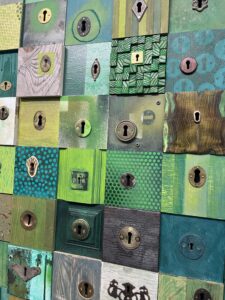As a society our relationship between nature and culture is deeply entangled. The many types of interactions between humans and the environment shape our perceptions and alter our outlook towards nature. Culture, language and symbols are all constructs that influence our perception of what we perceive as “natural”. These constructs are shaped by our cultural practices and mediate the way we perceive nature. This is easily highlighted through a few interesting examples from this week’s workshop.
Trade: Gravel
Gravel comes from a natural resource and is manmade in quarries by crushing the stones into gravel. This production of gravel is then distributed into our society. Nature provides us with the “natural” resource while our culture dictates how the raw material will be utilized due to our cultural specifications. The movement or “trade” of these goods alters our natural landscapes, impacting our natural environment, this illustrates how “trade” as a cultural activity is entangled and shaped by nature.

Pile of Gravel (Lancaster, J. 2024)
Home: Security
Home is a place that allows us to feel safe and secure. A home is a physical space and a cultural construct. A home in the physical sense is built in conjunction with natural landscapes and climates, constructed with raw materials provided by “nature”. While “culture” educates us on how the home is designed and the traditions in which a home is shaped. Culture educates us on what makes a home feel “secure”. Nature and culture intersect to create a home that joins us to the environment and society.

Keyholes/Security/Home (Lancaster, J. 2024)
Water: Growth
Water unites all living creatures, the world is made up of water, we as humans are mostly made of water. Nature cannot grow without water, nature feeds us, water is vital for our survival and growth as humans. In this sense we are not separate from nature, but the way we interact with water is shaped by culture. Many rituals such as baptisms involve water, symbolic of life, growth and renewal. This is our cultural way of connecting to the natural world. Water flows through both nature and culture to create growth.

Living Things (Lancaster, J. 2024)
Our cultural practices shape the way we design, they determine the way in which we consume raw materials. Our perceptions of these raw materials are mediated through our culture. For example, we often associate natural materials as being sustainable because they come from nature. But is this just our cultural perception of nature being a renewable source? By educating ourselves as designers we will be able to make informed decisions on ways in which design culture can benefit nature. I believe this is the way forward for designers wanting to create a sustainable approach to their practice.
Bibliography:
Fallen, K & Jørgensen, F.A. Histories of Design: Towards a New research Agenda. doi:10.1093/jdh/epx017. Journal of Design History. Vol. 30 No. 2
Accessed on 11/09/2018
Images:
Lancaster, J. 2024. Photos Around Campus





This is a well-written and reflective post, Josie. You thoughtfully explore the complex relationship between nature and culture. Your examples of gravel, home, and water nicely illustrate how our cultural practices influence our perceptions of natural resources and spaces. The questions you raise show a strong critical engagement with the topic. To build on this, you might add a bit more personal insight on how these reflections might shape your own design approach. Overall, this is an insightful post – nicely done!